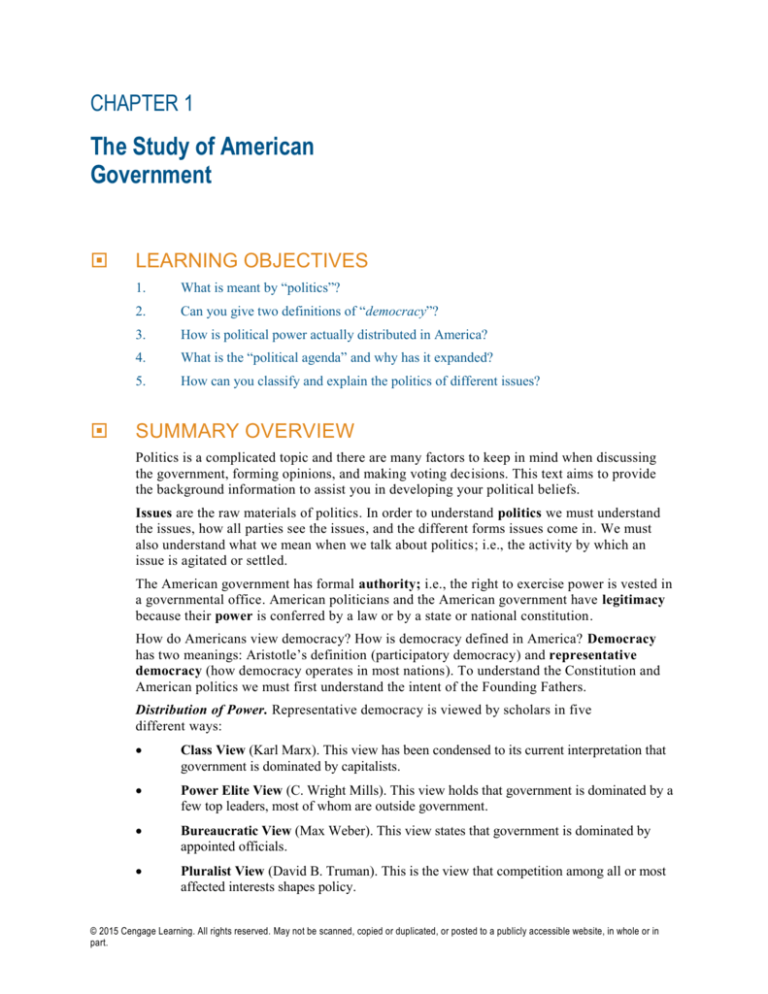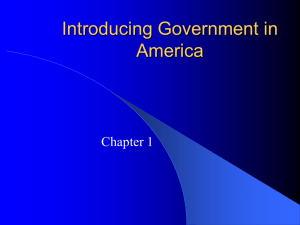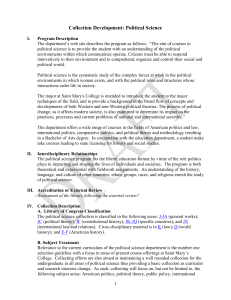
CHAPTER 1
The Study of American
Government
LEARNING OBJECTIVES
1.
What is meant by “politics”?
2.
Can you give two definitions of “democracy”?
3.
How is political power actually distributed in America?
4.
What is the “political agenda” and why has it expanded?
5.
How can you classify and explain the politics of different issues?
SUMMARY OVERVIEW
Politics is a complicated topic and there are many factors to keep in mind when discussing
the government, forming opinions, and making voting decisions. This text aims to provide
the background information to assist you in developing your political beliefs.
Issues are the raw materials of politics. In order to understand politics we must understand
the issues, how all parties see the issues, and the different forms issues come in. We must
also understand what we mean when we talk about politics; i.e., the activity by which an
issue is agitated or settled.
The American government has formal authority; i.e., the right to exercise power is vested in
a governmental office. American politicians and the American government have legitimacy
because their power is conferred by a law or by a state or national constitution.
How do Americans view democracy? How is democracy defined in America? Democracy
has two meanings: Aristotle’s definition (participatory democracy) and representative
democracy (how democracy operates in most nations). To understand the Constitution and
American politics we must first understand the intent of the Founding Fathers.
Distribution of Power. Representative democracy is viewed by scholars in five
different ways:
Class View (Karl Marx). This view has been condensed to its current interpretation that
government is dominated by capitalists.
Power Elite View (C. Wright Mills). This view holds that government is dominated by a
few top leaders, most of whom are outside government.
Bureaucratic View (Max Weber). This view states that government is dominated by
appointed officials.
Pluralist View (David B. Truman). This is the view that competition among all or most
affected interests shapes policy.
© 2015 Cengage Learning. All rights reserved. May not be scanned, copied or duplicated, or posted to a publicly accessible website, in whole or in
part.
2
Chapter 1: The Study of American Government
Creedal Passion View (Samuel P. Huntington). This view argues that morally
impassioned elites drive important political changes.
Who governs and to what ends? Knowing who governs, and what they stand for, provides
insight into political decisions (what will be done to and for us). Knowing to what ends gives
us an idea of how government affects our lives.
Politics consists of addressing the many issues our country faces on a daily basis; this is
known as the political agenda. The political agenda is affected by:
shared political values,
the weight of custom and tradition,
the impact of events, and
changes in the way political elites think and talk about politics.
The political agenda is impacted by:
the behavior of groups,
the workings of institutions,
the media,
and the action of state governments.
We can attempt to understand how the government handles a given issue by examining the
costs and benefits of the proposed policy. Costs and benefits can be reviewed based on the
perception of costs and benefits that affect politics and whether or not it is legitimate for that
group to benefit. This cost and benefit analysis toward government policies provides us with
a “simple theory of politics.”
Another aspect of government is the four different types of politics:
Majoritarian. Almost everyone benefits and almost everyone pays.
Interest group. One small group benefits and another small group pays.
Client. One small group benefits and almost everyone pays.
Entrepreneurial. Almost everyone benefits and a small group pays the cost.
These types of politics provide us with some perspective as to how the cost benefit analysis
of a governmental policy is interpreted by different schools of thought.
All of the items discussed in the text aim to give us insight into how preferences are formed,
which helps us understand why those who wield power are able to do so; simply put, why we
elect who we do.
We should take into account that a well-educated opinion of our government’s institutions
and interests can only be formed after examining the behavior of elected officials toward a
variety of issues. In order to form this educated opinion we must not only look at the current
behavior of our government, but also history, tradition, and belief.
© 2015 Cengage Learning. All rights reserved. May not be scanned, copied or duplicated, or posted to a publicly accessible website, in whole or in
part.
Chapter 1: The Study of American Government
CHAPTER OUTLINE
I.
Issues and Politics
II.
Power, Authority, and Legitimacy
III.
What Is Democracy?
IV.
Political Power in America: Five Views
V.
Who Governs—and to What Ends?
VI.
Expanding the Political Agenda
Groups
B.
Government Institutions
C.
Media
D.
Action by the States
VII.
The Politics of Different Issues
VIII.
Four Types of Politics
IX.
A.
A.
Majoritarian Politics: Distributed Benefits, Distributed Costs
B.
Interest Group Politics: Concentrated Benefits, Concentrated Costs
C.
Client Politics: Concentrated Benefits, Distributed Costs
D.
Entrepreneurial Politics: Distributed Benefits, Concentrated Costs
E.
Policy Dynamics: Inside/Outside the Box
Understanding Politics
TEACHING TOOLS
LEARNING OBJECTIVE 1: WHAT IS MEANT BY “POLITICS”?
Critical Thinking Question
How has the definition of politics changed since the Founding Fathers began creating the
Constitution (Philadelphia Convention)? Has American politics improved since this time?
Explain your answer.
In-Class Activity
How does politics affect this course? Should government play such a part in society? Start with
the smaller venue of the classroom and then have students expand the discussion.
© 2015 Cengage Learning. All rights reserved. May not be scanned, copied or duplicated, or posted to a publicly accessible website, in whole or in
part.
3
4
Chapter 1: The Study of American Government
Lecture Launcher
Does politics affect your daily life? How? Should citizens concern themselves with
such questions?
LEARNING OBJECTIVE 2: CAN YOU GIVE TWO DEFINITIONS
OF “DEMOCRACY”?
Critical Thinking Question
Explain the different forms of democracy presented in the text, then discuss why the Founding
Fathers chose the form of democracy they did for the operation of the U. S. Government.
In-Class Activity
Debate the decision made by the Founding Fathers that representative democracy is favorable
over direct or participatory government as the governing structure of the United States.
Lecture Launcher
There are many forms of government around the world; is democracy the best choice? Consider
how government affects citizens’ lives.
LEARNING OBJECTIVE 3: HOW IS POLITICAL POWER ACTUALLY
DISTRIBUTED IN AMERICA?
Critical Thinking Question
We have discussed five views of political power; explain each of these views and discuss what
you feel is the dominant view of political power and why.
In-Class Activity
How does your instructor have power over this course? How does this power correlate to the
power of the national government?
Lecture Launcher
According to Federalist No. 51: “You must first enable the government to control the governed,
and in the next place oblige it to control itself.” Have contemporary governments upheld the
principles as established by the Founding Fathers?
LEARNING OBJECTIVE 4: WHAT IS THE “POLITICAL AGENDA” AND WHY HAS
IT EXPANDED?
Critical Thinking Question
Discuss whether you feel the government creates the political agenda based on issues brought
forth from the people or what they perceive to be issues of the people. Consider what your text
says affects the political agenda.
© 2015 Cengage Learning. All rights reserved. May not be scanned, copied or duplicated, or posted to a publicly accessible website, in whole or in
part.
Chapter 1: The Study of American Government
5
In-Class Activity
Create a political agenda for this class. What outside forces affect the agenda and what power do
those outside forces have to alter this agenda?
Lecture Launcher
Does the current political agenda address items you feel are important to you? Do you feel the
government is in tune to its citizens?
LEARNING OBJECTIVE 5: HOW CAN YOU CLASSIFY AND EXPLAIN THE
POLITICS OF DIFFERENT ISSUES?
Critical Thinking Question
Explain how policies are evaluated for implementation by the government. What criteria are used
for evaluation? Do you feel this is the best method; why or why not?
In-Class Activity
Have the class choose a topic to apply the cost-benefit analysis. Examples could come from
their syllabus.
Lecture Launcher
Think about how you make a decision in your life; how does your process compare to that of
the government?
KEY TERMS
authority
The right to use power.
benefit
A satisfaction that people believe they will enjoy if a policy is
adopted.
bureaucratic view
View that the government is dominated by appointed officials.
class view
View that the government is dominated by capitalists.
client politics
A policy in which one small group benefits and almost
everybody pays.
cost
A burden that people believe they must bear if a policy is
adopted.
creedal passion view
View that morally impassioned elites drive important political
changes.
democracy
The rule of the many.
direct or participatory
democracy
A government in which all or most citizens participate
directly.
elite
Persons who possess a disproportionate share of some valued
resource, like money, prestige, or expertise.
© 2015 Cengage Learning. All rights reserved. May not be scanned, copied or duplicated, or posted to a publicly accessible website, in whole or in
part.
6
Chapter 1: The Study of American Government
entrepreneurial politics
A policy in which almost everybody benefits and a small
group pays.
interest group politics
A policy in which one small group benefits and another small
group pays.
issue
A conflict, real or apparent, between the interests, ideas, or
beliefs of different citizens.
legitimacy
Political authority conferred by law or by a state or national
constitution.
log-rolling
A legislator supports a proposal favored by another in return
for support of his or hers.
majoritarian politics
A policy in which almost everybody benefits and almost
everybody pays.
pluralist view
View that competition among all affected interests shapes
public policy.
policy entrepreneurs
Activists in or out of government who pull together a political
majority on behalf of unorganized interests.
political agenda
Issues that people believe require governmental action.
politics
The activity by which an issue is agitated or settled.
pork-barrel legislation
Legislation that gives tangible benefits to constituents in
several districts or states in the hope of winning their votes in
return.
power
The ability of one person to get another person to act in
accordance with the first person’s intentions.
power elite view
View that the government is dominated by a few top leaders,
most of whom are outside of government.
representative democracy
A government in which leaders make decisions by winning a
competitive struggle for the popular vote.
INSTRUCTOR RESOURCES
Huntington, Samuel P. American Politics: The Promise of Disharmony. Cambridge, MA:
Harvard University Press, 1981. A fascinating analysis of the American political
experience as shaped by recurring “creedal passion” periods.
Marx, Karl, and Friedrich Engels. “The Manifesto of the Communist Party.” In The Marx-Engels
Reader, 2d ed., edited by Robert C. Tucker. New York: Norton, 1978, 469–500. The
classic and historic statement suggesting that government is a mere instrument of the
economic elite (wealthy capitalists in the modern world).
Meyerson, Martin, and Edward C. Banfield. Politics, Planning, and the Public Interest.
New York: Free Press, 1955. An understanding of issues and politics comparable to the
approach adopted in this book.
© 2015 Cengage Learning. All rights reserved. May not be scanned, copied or duplicated, or posted to a publicly accessible website, in whole or in
part.
Chapter 1: The Study of American Government
7
Schumpeter, Joseph A. Capitalism, Socialism, and Democracy. 3d ed. New York: Harper
Torchbooks, 1950, chs. 20–23. A lucid statement of the theory of representative
democracy and how it differs from participatory democracy.
Truman, David B. The Governmental Process: Political Interests and Public Opinion. New York:
Knopf, 1951. A pluralist interpretation of American politics.
Weber, Max. From Max Weber: Essays in Sociology. Translated and edited by H. H. Gerth and
C. Wright Mills. London: Routledge & Kegan Paul, 1948, ch. 8. A theory of bureaucracy
and its power.
Wilson, James Q. Political Organizations. New York: Basic Books, 1973. It is from a theory
originally developed in this treatise that the four-box model of how to classify and
explain the politics of different issues that is presented in this chapter was derived.
© 2015 Cengage Learning. All rights reserved. May not be scanned, copied or duplicated, or posted to a publicly accessible website, in whole or in
part.









